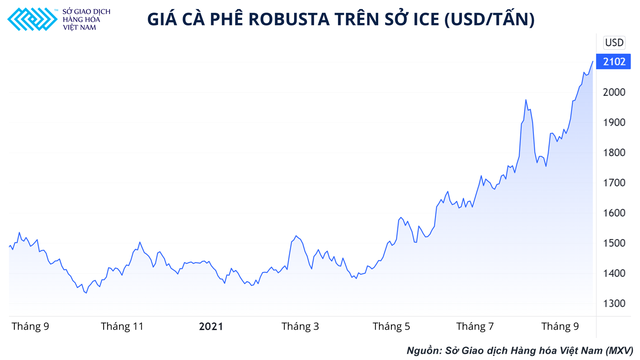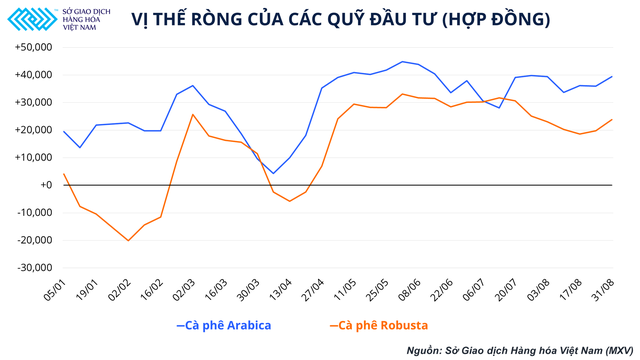Rarely has the coffee market been as active as it has been in more than a year. Since June 2020, the price of Arabica coffee has doubled to 4,255 USD/ton and there was a time when the price reached 4,600 USD/ton, the highest in the past 7 years. Robusta prices also increased by nearly 80% to $2,082/ton, the highest level since 2017. This galloping uptrend has not shown any sign of stopping. However, is this just a short-term derivatives market development or will each cup of coffee we use every day actually become more expensive?
Behind the dizzying increase
According to the Vietnam Commodity Exchange (MXV), coffee is the commodity with the strongest trading growth in the third quarter, with an average transaction value of over VND 1,200 billion per session. The growth rate of more than 20% per month shows the attractiveness of this trading item, but it is largely due to the large fluctuations in coffee prices on the two ICE London and ICE New York offices.
The rally was greatly supported by supply concerns, as the main coffee-producing states in Brazil were hit hard by drought and unusual frosts. The record high price of Arabica coffee in 7 years has made many roasters consider switching to Robusta coffee and push up the price of this coffee.

In addition, the Covid-19 pandemic caused a shortage of containers and increased freight rates, causing goods to be stuck at seaports in two major exporting countries in Southeast Asia, Vietnam and Indonesia. continued to drive coffee prices up after the weather concerns had passed. The world’s two leading corporations, Starbucks and Nestle, are both considering increasing the selling price of their products to offset the increase in input material prices.
However, just the above basic factors will not be enough for the price of coffee to rise and fall very sharply in a short time like the past, but the whole market is affected by the changes in positions of large investment funds. .
Investment funds, cash flow and market influence
Coffee is inherently sensitive to extreme weather, so a short-term drought or frost can affect yields. Therefore, many times the coffee market wobbles before the weather information.
Typically, the price increase because of the frost at the end of July, Arabica price increased by 35% in just 5 sessions, but then the strong selling force took only a week to blow away 2/3 of the value of the previous increase. there. The price of Robusta sold off so strongly that selling swept away the entire bullish chain. It can be seen that the fluctuations of the coffee market have been outside the law of supply and demand, and the price is affected by the movement of investment cash flow.
During the period from the beginning of June to the middle of July, the coffee market moved sideways with a wide range, making many investors feel discouraged because the market was so gloomy. Therefore, seizing the opportunity to have frost information, the market psychology was worried about the supply in Brazil will be affected causing the price to push up, large investment funds have pushed to sell, causing the price of coffee to drop sharply. . According to data from the ICE Exchange, investment funds have reduced their net buying volume since the beginning of June, and fell sharply along with the time when the coffee price lost 20% of its value.

In the Robusta market, the signs of speculation in the market are also increasingly clear, when the news about the epidemic and supply chain disruption in Vietnam is no longer new, but the price is still skyrocketing. Investment funds will probably find a way to sell when prices are high and wait until the harvest season in Vietnam will be completed in October and November, abundant supply causes prices to fall and this is the time. suitable point for funds to buy in.
The increase in coffee prices due to speculation not only makes it difficult for retail investors, but also makes coffee traders suffer a lot. In order to hedge risks when coffee prices rise too high, large coffee trading companies such as Dunkin Donut or Starbucks also have to increase their long positions to reduce losses to revenue when input prices rise. leap. As a result, these companies and retail investors must buy at high prices and suffer losses when the market fluctuates.
The phenomenon of price speculation in the coffee market has been criticized many times. The CEO of Starbucks has publicly criticized hedge funds and index funds for influencing coffee prices. Therefore, not only investors, but also coffee producers and exporters in Vietnam need to pay attention to this issue, avoiding the case of hoarding when the price of coffee increases, and then having to resell it. to cut losses when investors release bad news.
In addition, investors should carefully study and select information available on the market, as well as be cautious before extreme ups and downs in order to minimize risks when participating in the coffee market.
Coffee trading experience, investment cash flow analysis skills will be two of the main topics of the Webinar “Coffee Trading: Opportunities and a Global Perspective” hosted by the Commodity Exchange. Vietnam (MXV) and Intercontinental Exchange (ICE) co-organized at 15:00 on September 10, 2021. The sharing of experts from the two Departments will bring great value to the whole commodity trading industry in general and coffee in particular, helping domestic investors catch up with the world’s industries and Transactions become more efficient.
